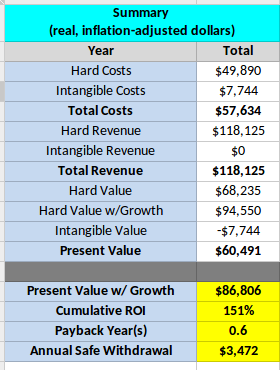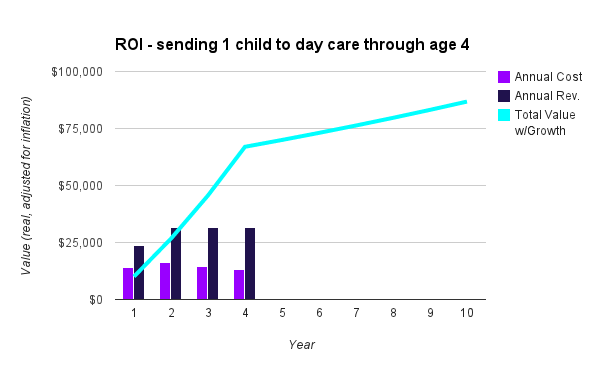
Abstract
Everyone knows that big kids are expensive, but little kids are expensive too. What if it made more sense for the typical American parent to quit their job for 4 years instead of sending their kid to daycare / childcare / pre-k during that time? Wouldn’t it be nice?
Yes, it would, but in fact, it is actually a huge opportunity cost for most people to quit their job to take care of kids. The situation isn’t without some advantages, though, like having more control over the very important early development years of your kid’s life.
It’s a complicated decision, but there are few data points here that hopefully make it a little less murky.
Introduction
Okay, so a few things. First, I broke my collarbone and typing is sort of a chore, so I’m hoping to keep this short. Second, the title of this post implies that I’m coming on a little more moral than is really the case. The point of today’s post is to examine whether or not it makes sense for the average American earner to pay for childcare.
I’ve been hearing a lot lately about how expensive childcare can be, especially for low-income single parents, and thought I would see what the numbers look like myself. Particularly, as we think about starting a family soon, I wanted to weigh the benefits of staying at home vs. going to work for either me or my wife.
The ROI below compares the cost of childcare to median after-tax (disposable) income for earners in American households. It turns out that staying at work and paying for childcare is in fact the better financial decision, at least on the surface for the variables I modeled.

The numbers
If you’re a normal 2.5 person household, chances are that you have about 1.3 earners in the house with a median disposable income of about $36,000 per earner. Wouldn’t it be nice to find out that daycare is so expensive that it doesn’t make sense for you to go to work when you have a young baby around the house?
I was hoping that is how things would turn out, but since daycare / childcare costs about $10,000 per year on average, you’d actually end up losing a lot of money by staying home rather than sending your kid to daycare. Even with two kids, the marginal advantage still seems to favor sending them both to daycare.
Specifically, the numbers for sending one kid to daycare versus staying home look something like this:


For twins, the numbers look like this:
- 10-Year NPV: $34,298
- 10-Year ROI: 36%
- 10-Year Payback: 1.0 years
As you can see, even with twins, it still pays to send them to daycare as opposed to quitting work for the typical American. Over the course of 10 years (really 4 with just some passive growth) the typical American will have saved more than 2 years of work with a single child or one year of work with twins by choosing to continue working.
Childcare is expensive, but not so expensive that it is prohibitive of work for many people. This isn’t, of course, necessarily true for low-income Americans, but that is another story.
Assumptions
So what’s baked into these numbers? As mentioned above they assume a $36,000 disposable income per household earner. They also assume childcare costs look something like this:
- Year 1: $12,000 (less 3 months for maternity leave)
- Year 2: $11,000
- Year 3: $9,500
- Year 4: $8,000 (possibly more for pre-k + afterschool program)
On top of that I’m counting work driving costs of about 32 miles per day at 40 cents per mile plus almost 50 minutes a day in the car at $10 per hour. I’m also assuming 10% lower salary because the average child spends 36 hours in day care, which probably means the parents work about 4 hours or 10% less than other full-time counterparts.
I’m not assuming any additional driving to and from daycare (assume it is on the way), and I’m not assuming any additional expenses such as increased meals out due to less free time for workers, even though these likely occur pretty frequently for young parents with full time jobs.
Some thoughts on intangible factors
Why did I really want to see a lower ROI for this example? Well mainly, because I’ve read a lot about how attentive and involved parenting in a kid’s early years can really pay dividends down the road in areas like intelligence, criminal behavior, educational attainment, etc. Early childhood is a time of rapid development for kids, and I’m the kind of control-freak parent that feels nervous letting someone else do that job for me.

There is the possibility that one’s own parenting and childcare could be so much better than what a child would receive at a local daycare that the positive difference in future earnings for that child would dwarf the short-term expenses. Apparently the difference between good childcare and average-to-bad child care can result in a 6-10% annual return on in investment over the course of a child’s life (I’m assuming this in inflation adjusted).
On the other hand, however, skipping work for four years has some major costs of its own. There are the direct costs, over two years of income according to this ROI, and then there are the intangible costs. Intangible costs such as skill attrition and lower bargaining power have the potential to severely erode lifetime earnings, as unfortunate as that may be. This isn’t necessarily a forgone conclusion; perhaps one enters the workforce after 4 years of stay-at-home childcare with renewed resolve and perspective on life, moving up the ladder much more quickly than they would otherwise…. it is difficult to say.
Conclusion
I personally like the idea of staying home to take care of my kids instead of sending them to daycare because of its simplicity. It just seems so natural, but the reality of the situation is that, at least on the surface, it is a pretty expensive luxury. For those that can afford it, more power to you. For the rest of us, it is a little more complicated.
There are of course alternatives to simply paying for daycare. There is the middle-ground option of part-time work, and then there are generous parents, relatives, and friends, not to mention probably numerous other hacks to make the first few years of childhood a little less expensive for parents.

Sources
- “Parents and the High Cost of Childcare” – Child Aware of America, 2013
- “How much you’ll spend on childcare” – Baby Center
- “Childcare and the overwhelmed parent” – NY Times
- Income data – wikipedia, ny times, and some calculations
*Final note: this ROI doesn’t place any dollar value on one’s time spend at home caring for a child. This is because I believe it would be a rewarding experience. It is not meant to discount the extraordinary hard work that is required to be a stay at home parent; the implicit assumption, however, is that it is a labor of love.